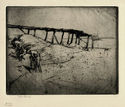
19th, 20th & 21st Century Fine Prints
707-546-7352 · fax 707-546-7924 · web: www.annexgalleries.com · email: artannex@aol.com
Allen Lewis Biography
Allen Lewis
American
1873–1957
Biography
Born in Mobile, Alabama, April 7, 1873, Allen Lewis moved at age four with his family to Buffalo, New York. When Lewis graduated from high school, he enrolled at the Buffalo Art Students League where he studied under the Canadian painter, George Bridgman. His work with Bridgman instilled a desire in Lewis that Buffalo, with its limited resources, could not satisfy. In search of greater opportunities, he sailed for Paris in 1894, at the age of 21. Every serious American art student in the late nineteenth century longed to study and work in Europe. Lewis quickly settled into his new life, writing his mother soon after his arrival that he had fallen in love with Paris. He soon began to take advantage of what the city offered the artist.
In October 1895, Lewis made his first etchings, some of which he proudly sent home. His friend, illustrator Ernest Haskell encouraged him in these earliest attempts. Lewis was pleased with one of his showings, as he wrote to his parents that his etching is placed along side of Whistler's and was “not hurt very much by the comparison although he is one of the greatest modern etchers as well as the greatest painter.” His entry was a portrait of the American illustrator, cartoonist, painter, and muralist, Boardman Robinson. Lewis had posed Robinson standing on the balcony because his studio was too small for the both of them to be in the room at the same time.
When Lewis returned to America he settled in New York and set up a studio in a warehouse owned by Hamilton Easter Field (1874-1922). Field, whom Lewis called his guardian angel, had helped the struggling artist to sell some of his prints in Paris. While in Paris, Lewis had designed five lithographed bookplates for Field, and then created two more following his return. The generous Field introduced Lewis to many of his friends, who in turn offered commissions to the young artist. Much of the demand was for Lewis's bookplates, executing more than fifty bookplates in the course of his career. Lewis produced two bookplates for Paul Burry Haviland (1880-1950), a member of the Limoges china-making family and Field's cousin, in 1904 and 1906.
In 1915, Lewis received his first commission for illustrations for Journeys to Bagdad, a book by Charles S. Brooks. With this work Lewis established his characteristic approach to book illustration, carefully considering the relation of the image to the page as a whole and taking particular pains with both the type design and the lettering. To Lewis these were as important as the illustrations to the visual integrity of the book as a whole. The editorial staff of The New Yorker must have admired Lewis's taste, for the magazine pirated for its cover masthead and paragraph headings the title page typestyle Lewis had used in Journeys to Bagdad.
Lewis exhibited his works and won honors for them throughout his career. In 1904 the first honor came through a bronze medal at the St. Louis Exposition. A decade later, at the 1915 Panama Pacific Exposition in San Francisco, he won a gold medal for his showing. In the following year, Lewis participated in the first annual exhibition of the Brooklyn Society of Etchers, an organization of which he served as the first president. Finally, in 1929, he was elected an Associate of the National Academy of Design, and in 1935 made a full Academician.
Through his teaching, Lewis was able to transmit his convictions about art to a new generation of students. He taught printmaking and illustration at the Art Students League in New York from 1924 until 1932. Between 1932 and 1934 he taught at the New School for Social Research in New York. Lewis did not like to lecture, but preferred to work with his students individually, conveying to them that appreciation of line and form so important to him. His students included Norman Kent (1903-72), Warren Chappell (b. 1904-), and John Howard Benson (1901-56).
Lewis was at the height of his career during the 1930s, but the 1940s proved discouraging for him. He began to receive fewer commissions, and his health deteriorated. Never an extrovert, he lacked a keen business sense, and his precise techniques made his work slow and difficult. When his former student, Norman Kent, wrote about Lewis' long and quiet life, he noted that Lewis “considered himself a failure.” Lewis never did achieve the wide success of some of his contemporaries, such as Rockwell Kent (1882-1971), but shaped the work of many that followed.
Allen Lewis died in Basking Ridge, New Jersey on March 20, 1957 at the age of 83.
Biography from the Allen Lewis Papers, Wheaton College, Wheaton, Illinois








